Japan 2022 "50th anniversary of the establishment of Japan - Mongolia diplomatic relations"
| <prev | back to index | next> |
| Issue Date | 15.06.2022 |
| ID | Michel: 11444-11453 ; Scott: 4598a-j ; Stanley Gibbons: ; Yvert et Tellier: 11047-11056 ; Category: pR |
| Design | Yasuko Yamada. Advice and supervision: Professor Emeritus from the University of Tokyo Jin Murata, Shinobu Ishigaki, Director and Special Professor, Dinosaur Science Museum, Okayama University of Science. |
| Stamps in set | 10 |
| Value |
84 Yen *10: (1) Altay Tawan Bogd (2) Eagle Hunter (3) Reindeer grazing (4) Wolves (Eurasian wolves) (5) Scabiosa comosa (6) Gel (7) Amur Ito (Taimen) (8) Grazing scenery (9) Bactrian camel and Gobi (10) Large dinosaur Saurolophus and footprints Margins / Sauropods dinosaur and footprints (reconstruction based on fossils) |
| Size (width x height) |
Mini-Sheet size: 127.0 mm x 187.0 mm Stamp sizes: (1), (3), (8), (9) 32.0 mm x 40.0 mm (2) 38.0mm x 33.0mm (4), (5) 31.0mm x 38.0mm (6) 30.0 mm x 41.0 mm (7) 26.0 mm x 42.0 mm (10) 31.0 mm x 42.0 mm |
| Layout | Mini-Sheets of 10 self-adhesive stamps |
| Products | |
| Paper | |
| Perforation | die-cut |
| Print Technique | Offset, 6 colors |
| Printed by | Philaposte |
| Quantity | 700.000 sheets |
| Issuing Authority | Japan Post Co., Ltd. |
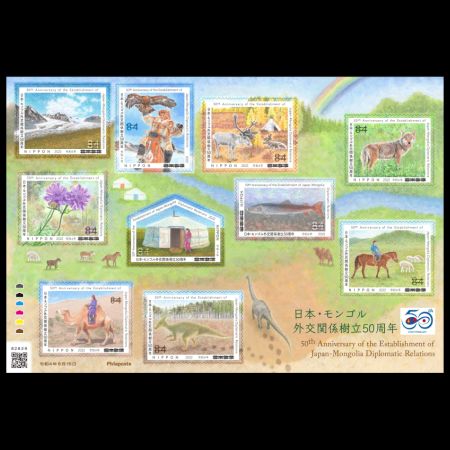
On June 16th 2022, the Post Authority of Japan issued a Mini-Sheet with 10 self-adhesive stamps "50th anniversary of the establishment of Japan - Mongolia diplomatic relations".
The Mini-Sheet contain stamps of slightly different sizes with motifs of the scenery, culture, and creatures that are symbols of Mongolia.
- Altai Tavan Bogd National Park,
is a national park in Bayan-Ölgii Province of western Mongolia.
The park includes the Mongolian side of the Tavan Bogd massif, which is divided by the triple border with Russia and China in the Altai Mountains. It is the highest mountain in the country. - Eagle Hunter The westernmost province of Bayan-Ulgii in Mongolia is inhabited by Turkic Kazakhs. Eagle Hunt is a part of Kazakh culture that trains and hunts with golden eagles.
- Reindeer grazing. An ethnic minority called the "Tsaatan", live in the Taiga region near Lake Khuvsgul in Mongolia, who breed reindeers.
- Eurasian wolf
- Scabiosa the national flower of Mongolia.
- Ger, Mongolian Traditional Dwelling. The poles are made of wood and the cover is made of felt.
- Amur Ito (Taimen), salmonid fish. It resembles "Ito", which is famous as a "phantom fish" in Japan and is one of the largest fish inhabiting rivers in Mongolia.
- Grazing scenery In Mongolia, nomadic farming (a lifestyle of grazing livestock while moving according to the season) has been practiced. Mongolia Nomads graze and care for livestock every day as shown in this picture, and sheep are bred all over Mongolia.
- Bactrian camel and Gobi Desert. Bactrian camel (Camelus bactrianus), also known as the Mongolian camel or domestic Bactrian camel. In particular, a population of wild Bactrian camel has been discovered to live within a part of the Gashun Gobi region of the Gobi Desert. The Gobi Desert is a large desert or brushland region in East Asia. The Gobi Desert is very famous for its dinosaur discoveries.
- Dinosaur Saurolophus and its footprints: described below.
Selvage: Sauropod dinosaur and its footprints.
It depicts the world's largest ichnofossil (trace fossils) found in Mongolia and the
sauropod dinosaurs that are believed to have made those footprints: described below. - [R1] Technical details and stamps presentation: Official press release (in Japanese).
- [R2] Dinosaurs discovered in Mongolia: NHM in London,
- [R3] Saurolophus:
Wikipedia,
"Report on the Japan - Mongolia Joint Paleontological Expedition to the Gobi Desert, 1998", by Suzuki, Shigeru; Watabe, Mahito; Hayashibara Museum of Natural Sciences - Mongolian Paleontological Center Joint Paleontological Expedition. - [R4] Giant footprint:
BBC,
Dogonews,
Washingtop Pst,
- "Report of the Okayama University of Science - Mongolian Institute of Paleontology and Geology Joint Expedition in 2016", by Shinobu iShigaki (Japan), Khishigjav TsogtBaatar (Mongolia) and team.
- "Report of the Okayama University of Science – Mongolian Institute of Paleontology and Geology Joint Expedition in 2017", by Shinobu iShigaki (Japan), Khishigjav TsogtBaatar (Mongolia) and team.
- "Dinosaur tracks at the Nemegt locality: Paleobiological and paleoenvironmental implications", by Judai Nakajima and team, https://doi.org/10.1016/j.palaeo.2017.10.026
- "A giant sauropod footprint from the Nemegt Formation (Upper Cretaceous) of Mongolia", by Brennan Stettner and team, https://doi.org/10.1016/j.palaeo.2017.10.027
- "Rediscovery of the type localities of the Late Cretaceous Mongolian sauropods Nemegtosaurus mongoliensis and Opisthocoelicaudia skarzynskii: Stratigraphic and taxonomic implications", by Philip J. Currie and team, https://doi.org/10.1016/j.palaeo.2017.10.035
- [R5] Titanosaurus: Wikipedia, Encyclopedia britannica.
- [R6] Mamenchisaurus: Wikipedia.
- [R7] Nemegtosaurus: Wikipedia.
- [R8] Opisthocoelicaudia: Wikipedia.
- Many thanks to Dr. Peter Voice from Department of Geological and Environmental Sciences, Western Michigan University, for reviewing the draft page and his very valuable comments.
- Many thanks to fellow collectors Mr. Ruben Guzman-Gutierrez from Mexico and Mr. Mitsuhiko Sakanoue from Japan for their help finding an information about these stamps and the dinosaurs depicted on them.
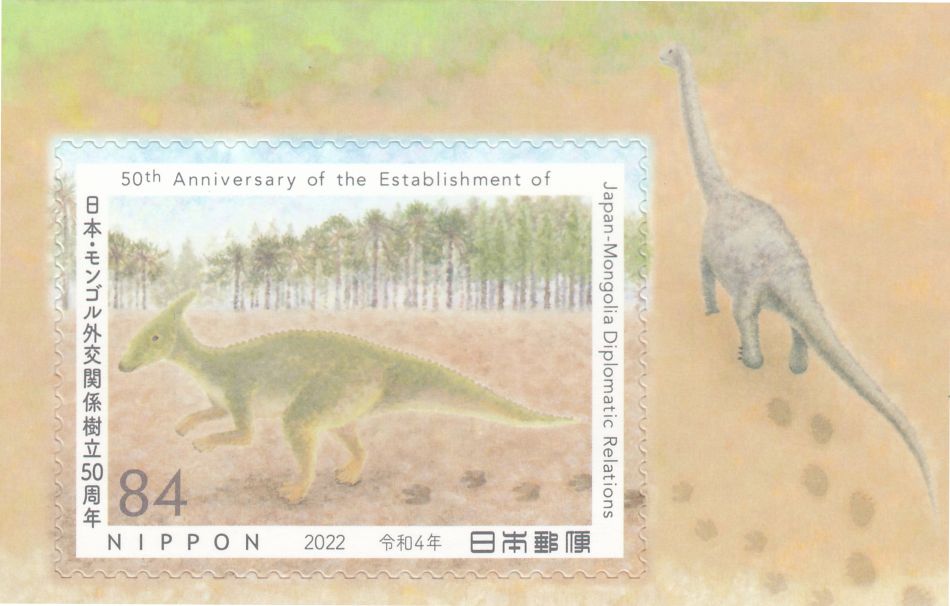
Saurolophus and Sauropod on "50th anniversary of the establishment of Japan - Mongolia diplomatic relations" Mini-Sheet of Japan 2022
Saurolophus [R3]
Saurolophus is a genus of large hadrosaurid dinosaur from the Late Cretaceous of Asia and North America, that lived approximately 70 million to 68 million years ago.
It is one of the few genera of dinosaurs known from multiple continents. Saurolophus is distinguished by a spike-like crest which projects up and back from the skull. The crest has been interpreted as a marker for sexual identification. Unlike lambeosaurines, the crests are made up completely of the nasal bone.
It was an herbivorous dinosaur which could move about either bipedally or quadrupedally. Its teeth were continually replaced and packed into dental batteries that contained hundreds of teeth.
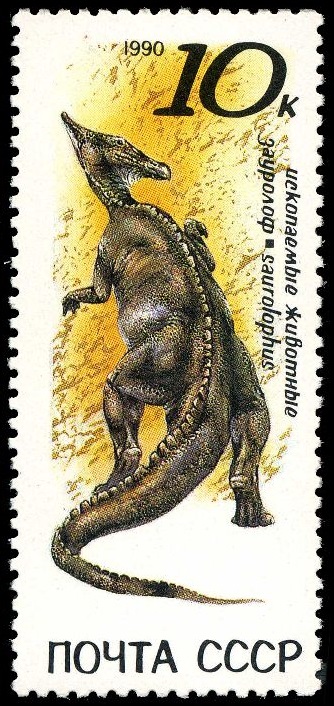 |
| Saurolophus on stamp of USSR 1990 MiNr.: 6119, Scott: 5923. |
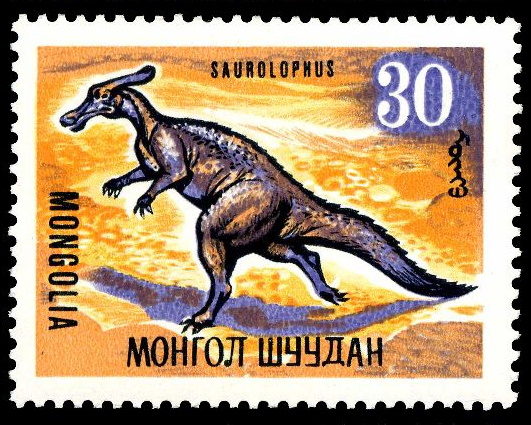 |
| The first stamp of Saurolophus, Mongolia 1967 MiNr.: 464, Scott: 451. |
The fossil is on display in the American Museum of Natural History
The second species, Saurolophus angustirostris, was described by Soviet paleontologist, Anatoly Konstantinovich Rozhdestvensky in 1947 from Mongolian fossils, from the Nemegt Formation in Gobi desert.
The 1946–1949 Soviet-Mongolian paleontological expeditions discovered the large skeleton that became known as Saurolophus angustirostris. The fossil is on display in the paleontological Museum in Moscow.
The Mongolian species is larger the American one, had a longer skull and the front of the snout (the premaxillary bones) was more upwardly directed. The length of the dinosaur was about was about 13 meters long, including 1.2 meter long skull and has an estimated weight of around 11 tonnes. Aside from size, the two species are virtually identical.
In 1998, some fossils and footprint of Saurolophus were discovered by Japanese-Mongolian paleontological expedition.
The first discovery of dinosaur footprints in Mongolia was made by Polish paleontologist Namnandorzhi in 1957.
The first discovery of dinosaur footprints by Japanese paleontologists was in 1995, when
the Hayashibara Museum of Natural Sciences (HMNS) — Mongolian Paleontological Center (MPC) Joint Paleontological
Expedition (HMNS-MPC Expedition) discovered abundant dinosaur footprints in the Upper Cretaceous of Shar Tsav,
275 km east of Dalanzadgad, South Gobi Aimag.
A total of about 18 000 footprints were discovered at Shar Tsav.
By the 2008 field season, the HMNS-MPC Expedition had discovered 18 new dinosaur tracksites and more than 20 000 dinosaur footprints from the Upper Cretaceous of Mongolia, including some footprints of Saurolophus.
Sauropod's footprint [R4]
According to the press release the dinosaur and its footprints on the selvage of the sheet, represents the world's largest ichnofossil (trace fossils) found in Mongolia and the Sauropod dinosaurs that are believed to have made those footprints.
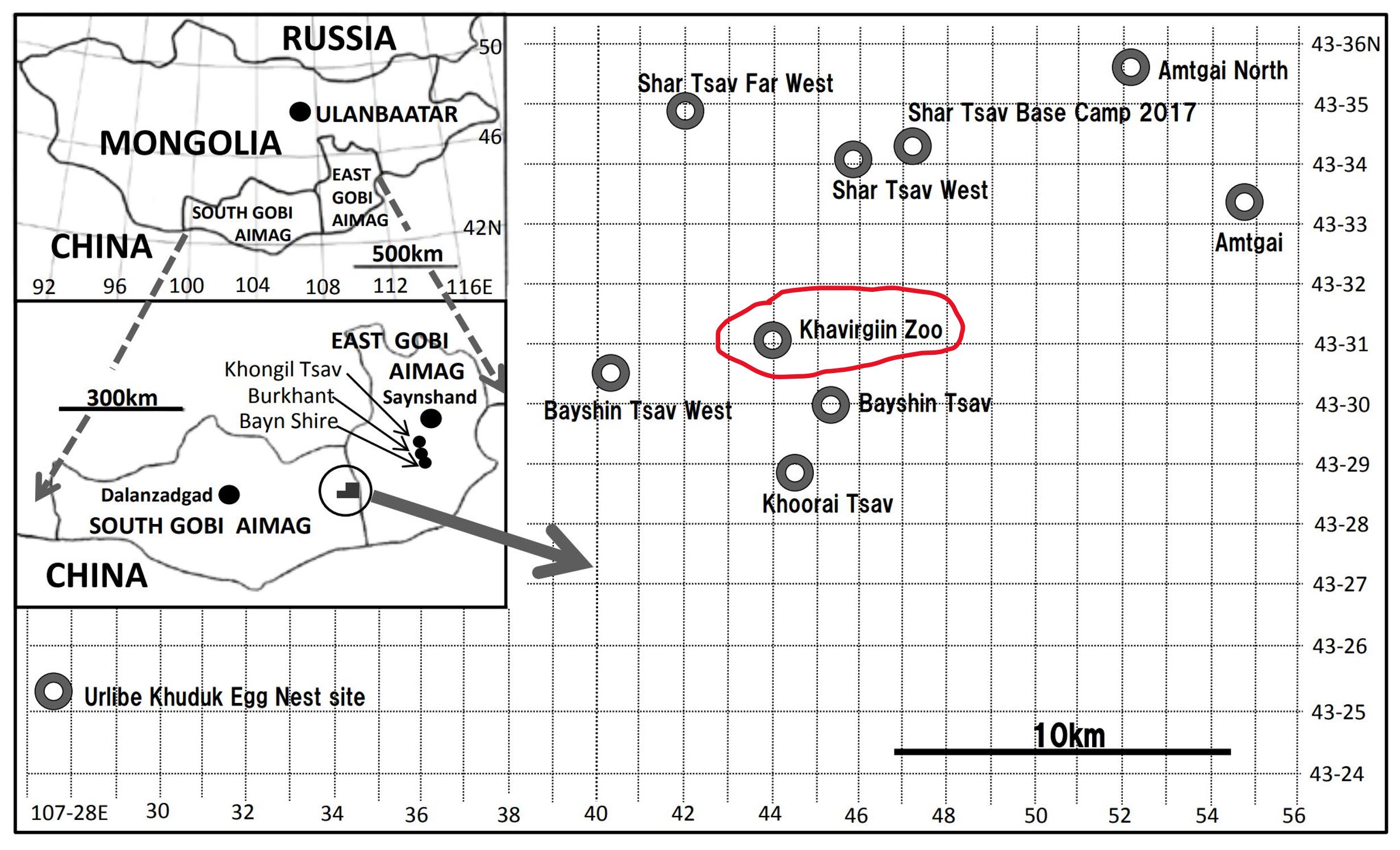 |
| Map of fossil sites visited by the expedition in 2016-2017 image credit:dinosaur.ous.ac.jp. |
It was discovered in a geological layer formed 70 to 90 million years ago. Based on the size of the footprint, the researchers inferred that it belongs to Titanosaurus.
Titanosaur refers to a group of Sauropods (family level - Titanosauroidea) which includes the genus Titanosaurus
amongst other genera (Patagotitan from Argentina for example).
These dinosaurs lived from the Late Jurassic Epoch (163.5 million to 145 million years ago) to the end of the Cretaceous Period
(145 million to 66 million years ago).
Titanosaurus, literally meaning 'titanic lizard', was named after the mythological Titans, first described by Richard Lydekker in 1877,
based on fossil found in India.
Titanosaur fossils have been found on all continents except Antarctica and include some 40 species.
The group contains the largest terrestrial animals known.
They are thought to have been more than 30 meters long and 20 meters tall. [R5]
In June 2021, the "Khavirgiin Zoo" paleontological site was added to the list of historical and cultural monuments under state protection.
“The footprint is one of the biggest known footprints in the world,” said Shinobu Ishigaki, a researcher at the Okayama University of Science in Japan and a member of the joint Mongolian-Japanese expedition to the Gobi.
During the next year, the expedition continued to dig at the same site and discovered another 3 large footprints. Two of these four casts are 106 cm in length and well preserved.
These footprints probably belong to different individuals as their direction is not parallel, some are even perpendicular to others.
The step length is 220 cm. The estimated movement speed by the formula is 1.6 km/h to 1.9 km/h.
They were formed in red muddy fine-grained sandstone when the dinosaur walked in what was once soft ground.
What makes the discovery even more exciting is that the footprint is a natural cast, created by sand and silt that filled the dent left by creature’s left foot as it stomped the muddy ground. Previous dinosaur footprints have all been indentations, and therefore, not as well-defined. Hence, for the first time, researchers will be able to study the shape of the entire foot, including the three claws, and learn more about how the massive animals walked the earth.
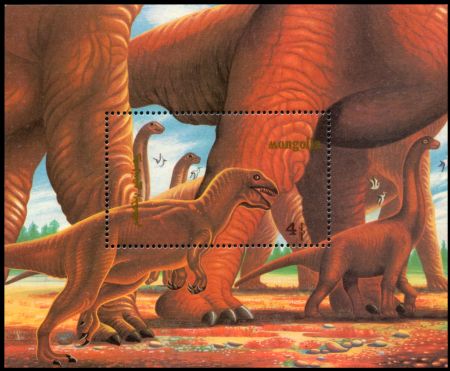 |
| Sauropod foot, with claws, on stamp of Mongolia 1990, MiNr.: Bl. 153, Scott: 2145 |
Since then many thousands of dinosaurs footprints were discovered in Mongolian desert.
Between 1995 and 2008, paleontologists found more than 20,000 preserved tracks belonging to a variety of dinosaur species.
Fossils of Sauropods from Mongolia have been known for more than 50 years before the discovery of these footprints.
In 1965, the Polish-Mongolian Palaeontological Expeditions discovered two sauropods from the Nemegt Formation of the Nemegt Basin, Mongolia.
One specimen, a nicely preserved, complete skull that in 1971 became the holotype of Nemegtosaurus mongoliensis, was found in Central Sayr at the Nemegt Locality.
The other was found at Altan Uul IV and is a nearly complete postcranial skeleton lacking only the skull and neck.
In 1977, this skeleton became the holotype of Opisthocoelicaudia skarzynskii.
Nemegtosaurus and Opisthocoelicaudia were initially assigned to different sauropod higher taxa, Dicraeosaurinae and Camarasauridae respectively.
However, since the late 1990s, both genera have been recognized as members of the Titanosauria.
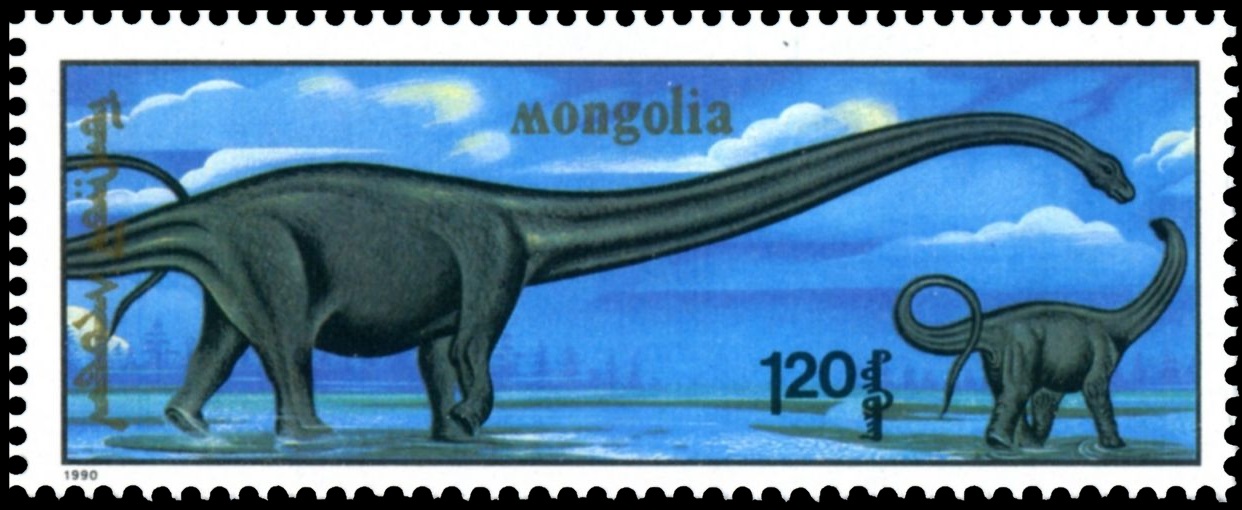 |
| Mamenchisaurus sauropod on stamp of Mongolia 1990, MiNr.: 2172, Scott: |
Products and associated philatelic items
| FDC [1] | ||
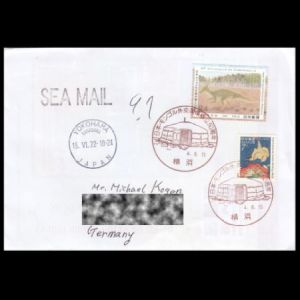 |
|
|
Notes:
[1] Japanese Post Authority didn't produce any official FDC. The cover above was cancelled by of one of two commemorative postmarks associated with the stamps set, then posted to Germany on the First Day of the Stamp Issue.
References

|
Acknowledgements
| <prev | back to index | next> |